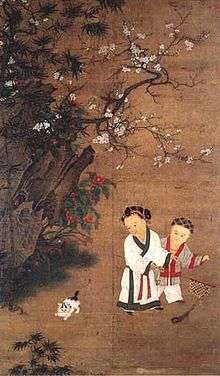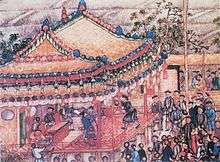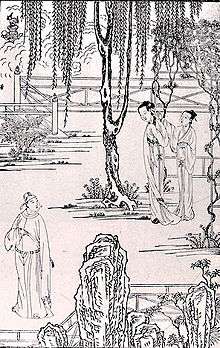Chinese opera
| Music of China | |
|---|---|
 | |
| General topics | |
| Genres | |
| Specific forms | |
| Media and performance | |
| Music festivals | Midi Modern Music Festival |
| Music media | |
| Nationalistic and patriotic songs | |
| National anthem | |
| Regional music | |
| Chinese opera | |||||||||||||||||||
| Traditional Chinese | 戲曲 | ||||||||||||||||||
|---|---|---|---|---|---|---|---|---|---|---|---|---|---|---|---|---|---|---|---|
| Simplified Chinese | 戏曲 | ||||||||||||||||||
| |||||||||||||||||||
Chinese opera (Chinese: 戲曲; pinyin: xìqǔ; Jyutping: hei3 kuk1) is a popular form of drama and musical theatre in China with roots going back to the early periods in China. It is a composite performance art that is an amalgamation of various art forms that existed in ancient China, and evolved gradually over more than a thousand years, reaching its mature form in the 13th century during the Song Dynasty. Early forms of Chinese drama are simple, but over time they incorporated various art forms, such as music, song and dance, martial arts, acrobatics, as well as literary art forms to become Chinese opera.[1]
There are numerous regional branches of Chinese opera, including the Beijing opera, Shaoxing opera, Cantonese opera and kunqu and Lvju.
History
Six Dynasties to Tang
An early form of Chinese drama is the Canjun Opera (參軍戲, or Adjutant Play) which originated from the Later Zhao Dynasty (319-351).[2][3][4] In its early form it was a simple comic drama involving only two performers, where a corrupt officer, Canjun or the adjutant, was ridiculed by a jester named Grey Hawk (蒼鶻).[2] The characters in Canjun Opera are thought to be the forerunners of the fixed role categories of later Chinese opera, particularly of its comic chou (丑) characters.[5]
Various song and dance dramas developed during the Six Dynasties period. During the Northern Qi Dynasty, a masked dance called the Big Face (大面, which can mean "mask", alternatively daimian 代面, and it was also called The King of Lanling, 蘭陵王), was created in honour of Gao Changgong who went into battle wearing a mask.[6][7] Another was called Botou (撥頭, also 缽頭), a masked dance drama from the Western Regions that tells the story of a grieving son who sought a tiger that killed his father.[8] In The Dancing Singing Woman (踏謡娘), which relates the story of a wife battered by her drunken husband, the song an dance drama was initially performed by a man dressed as a woman.[7][9] The stories told in of these song-and-dance dramas are simple, but they are thought to be the earliest pieces of musical theatre in China, and the precursors to the more sophisticated later forms of Chinese opera.[7][10]
These forms of early drama were popular in the Tang Dynasty where they further developed. For example, by the end of the Tang Dynasty the Canjun Opera had evolved into a performance with more complex plot and dramatic twists, and it involved at least four performers.[11] The early form of Chinese theatre became more organized in the Tang Dynasty with Emperor Xuanzong (712–755), who founded the "Pear Garden" (梨园/梨園; líyuán), the first academy of music to train musicians, dancers and actors.[12] The performers formed what may be considered the first known opera troupe in China, and mostly performed for the emperors' personal pleasure. To this day operatic professionals are still referred to as "Disciples of the Pear Garden" (梨园弟子 / 梨園弟子, líyuán dìzi).[13]

Song to Qing
By the Song Dynasty, Canjun Opera had become a performance that involved singing and dancing, and led to the development of Zaju (雜劇). Forms such as the Zaju and Nanxi (南戏) further matured in the Song Dynasty (960–1279). In the Yuan Dynasty (1279–1368), which acts based on rhyming schemes plus the innovation of having specialized roles like Dan (旦, dàn, female), Sheng (生, shēng, male), Hua (花, huā, painted-face) and Chou (丑, chŏu, clown) were introduced into the opera. Although actors in theatrical performances of the Song Dynasty strictly adhered to speaking in Classical Chinese onstage, during the Yuan Dynasty actors speaking or performing lyrics in the vernacular tongue gained precedent on stage.[14]
In the Yuan poetic drama, one person sang for the all four acts, but in the poetic dramas that developed from Nanxi during the Ming Dynasty (1368–1644), all the characters were able to sing and perform. A playwright Gao Ming late in the Yuan Dynasty wrote an opera called Tale of the Pipa which became highly popular, and became a model for Ming Dynasty drama as it was the favorite opera of the first Ming emperor Zhu Yuanzhang.[15][16] The presentation by now resemble the Chinese opera of today, except that the librettos were then very long.[1] The operatic artists were required to be skilled in many fields; according to Recollections of Tao An (陶庵夢憶) by Zhang Dai, performers had to learn how to play various musical instruments, singing and dancing before they were taught acting.[17]
The dominant form of the Ming and early Qing dynasties was Kunqu, which originated in the Wu cultural area. A famous work in Kunqu is The Peony Pavilion by Tang Xianzu. Kunqu later evolved into a longer form of play called chuanqi, which became one of the five melodies that made up Sichuan opera.[18] Currently Chinese operas continue to exist in 368 different forms, the best known being Beijing opera, which assumed its present form in the mid-19th century and was extremely popular in the latter part of the Qing Dynasty (1644–1911).

In Beijing opera, traditional Chinese string and percussion instruments provide a strong rhythmic accompaniment to the acting. The acting is based on allusion: gestures, footwork, and other body movements express such actions as riding a horse, rowing a boat, or opening a door. Spoken dialogue is divided into recitative and Beijing colloquial speech, the former employed by serious characters and the latter by young females and clowns. Character roles are strictly defined. Elaborate make-up designs portray which character is acting. The traditional repertoire of Beijing opera includes more than 1,000 works, mostly taken from historical novels about political and military struggles.
1912–1949
In traditional Chinese theater, prior to Yuan Dynasty, no plays were performed in vernacular Chinese or without singing. Opera masks of all sorts of colors were used in many Chinese operas. At the turn of the 20th century, Chinese students returning from abroad began to experiment with Western plays. Following the May Fourth Movement of 1919, a number of Western plays were staged in China, and Chinese playwrights began to imitate this form. The most notable of the new-style playwrights was Cao Yu (b. 1910). His major works—Thunderstorm, Sunrise, Wilderness, and Peking Man—written between 1934 and 1940, have been widely read in China.
In the 1930s, theatrical productions performed by traveling Red Army cultural troupes in Communist-controlled areas were consciously used to promote party goals and political philosophy. By the 1940s, theater was well established in the Communist-controlled areas.
1949–1985

In the early years of the People's Republic of China, the development of Beijing opera was encouraged; many new operas on historical and modern themes were written, and earlier operas continued to be performed. As a popular art form, opera has usually been the first of the arts to reflect changes in Chinese policy. In the mid-1950s, for example, it was the first to benefit under the Hundred Flowers Campaign, such as the birth of Jilin opera. Similarly, the attack in November 1965 on Beijing deputy mayor Wu Han and his historical play, Hai Rui Dismissed from Office, signaled the beginning of the Cultural Revolution. During the Cultural Revolution, most opera troupes were disbanded, performers and scriptwriters were persecuted, and all operas were banned except the eight "model operas" that had been sanctioned by Jiang Qing and her associates. Western-style plays were condemned as "dead drama" and "poisonous weeds" and were not performed. After the fall of the Gang of Four in 1976, Beijing Opera enjoyed a revival and continued to be a very popular form of entertainment both in theaters and on television.
Present
Chinese opera is seldom publicly staged in the 21st century, except in formal Chinese opera houses, and during the lunar seventh month Chinese Ghost Festival in Asia as a form of entertainment to the spirits and audience. More than thirty famous forms of Chinese opera continue to be performed today are came from Kunqu, including Journey of the West, Romance of Three Kingdom,the Peony Pavilion, and the Peach Blossom Fan.These masks were based on the ancient face painting tradition where warriors decorated themselves to scare the enemy.
In 2001, Kunqu was recognized as Masterpiece of Oral and Intangible Heritage of Humanity by United Nations Educational, Cultural and Scientific Organization (UNESCO)
Costuming
Exaggerated paints on opera performer's face which ancient warriors decorated themselves to scare the enemy are used in the opera; each color has a different meaning. They are used to symbolize a character's role, fate, and illustrate the character's emotional state and general character.
White symbolizes sinister, evil, crafty, treacherous, and suspicious. Any performer with white painted face usually takes the part of a villain of the show. The larger the white painted area, the crueler the role.
Green denotes impulsive behavior, violence, no self-restraint or self-control.
Red stands for bravery or loyalty.
Black denotes boldness, fierceness, impartiality, rough.
Yellow symbolizes ambition, fierceness, or intelligence.
Blue stands for steadfastness ( someone who is loyal and sticks to one side no matter what ).
Pink symbolizes sophistication, and cool-headedness.
Moreover, paint figures have different types. For instance, overall painted face, and only painted in the center of the face, connecting eyes and nose.
Varieties
 |
Recognize mutually (認相)
A Cantonese opera song by two female singers Bak Sheut Sin and Yam Kim Fai. Yam Kim Fai is actually using her trademark indistinguishable male voice behind the opera disguise. Only traditional Chinese instruments are used. Eighteen miles away (十八相送)
A Huangmei opera song by Ivy Ling Po partnering with Jenny Tseng. It sounds quite different from other operas. |
| Problems playing these files? See media help. | |
Northern
- Beijing opera (Peking Opera) (京剧)
- Yu opera (豫剧)
- Errenzhuan/Bangzixi/Benbeng opera (二人转) (Northeast China)
- Hebei bangzi (河北梆子) (Hebei)
- Jiju (吉剧) (Jilin)
- Lüju (吕剧) (Shandong)
- Maoqiang (茂腔) (Shandong)
- Pingju (评剧) (Hebei)
- Puju (蒲剧) (Shanxi)
- Qinqiang/Qin dynasty opera (秦腔) (Shaanxi)
- Zaju (雜劇)
- Jinju (晋剧) (Shanxi)
Southern
|
Gallery
-

Print illustration of zaju plays by Yuan playwrights, a book of the Wanli period (1572–1620).
-

Fire spitting from Sichuan opera
-

The informal costume of Huangmei opera
-

A performer
See also
- Culture of China
- Music of China
- Opera
- Pear Garden
- Qu (poetry)
- Yuan poetry
- Zaju
- Revolutionary opera
- Chinese contemporary classical opera
Notes
- 1 2 Wang Kefen (1985). The History of Chinese Dance. China Books & Periodicals. p. 78. ISBN 978-0835111867.
- 1 2 Tan Ye (2008). Historical Dictionary of Chinese Theater. Scarecrow Press. p. 3. ISBN 978-0810855144.
- ↑ "唐代參軍戲". 中國文化研究院.
- ↑ "Sichuan Opera". Archived from Chengdu China sichuan opera the original Check
|url=value (help) on February 24, 2007. - ↑ "The Tang Dynasty (618–907)". Asian Traditional Theatre and Dance.
- ↑ Laurence Picken, ed. (1985). Music from the Tang Court: Volume 5. Cambridge University Press. pp. 1–12. ISBN 978-0521347761.
- 1 2 3 Faye Chunfang Fei, ed. (2002). Chinese Theories of Theater and Performance from Confucius to the Present. University of Michigan Press. pp. 28–29. ISBN 978-0472089239.
- ↑ Tan Ye (2008). Historical Dictionary of Chinese Theater. Scarecrow Press. p. 336.
- ↑ "Theatre". China Culture Information Net.
- ↑ "The Early History of Chinese Theatre". Asian Traditional Theatre and Dance.
- ↑ Jin Fu (2012). Chinese Theatre (3rd ed.). Cambridge University Press. p. 10. ISBN 978-0521186667.
- ↑ Tan Ye (2008). Historical Dictionary of Chinese Theater. Scarecrow Press. p. 223. ISBN 978-0810855144.
- ↑ "Chinese Opera". onlinechinatours.com. Retrieved 2011-07-12.
- ↑ Rossabi, 162.
- ↑ Faye Chunfang Fei, ed. (2002). Chinese Theories of Theater and Performance from Confucius to the Present. University of Michigan Press. p. 41. ISBN 978-0472089239.
- ↑ Jin Fu (2012). Chinese Theatre (3rd ed.). Cambridge University Press. p. 447. ISBN 978-0521186667.
- ↑ "陶庵夢憶/卷02 《朱雲崍女戲》".
- ↑ Ccnt chuanju five melodic styles
References
- Rossabi, Morris (1988). Khubilai Khan: His Life and Times. Berkeley: University of California Press. ISBN 0-520-05913-1.
Further reading
| Wikimedia Commons has media related to Chinese opera. |
- Shih, Chung-wen (1976). The Golden Age of Chinese Drama: Yüan Tsa-chu. Princeton, NJ: Princeton University Press. ISBN 0-691-06270-6.
- Riley, Jo (1997). Chinese Theatre and the Actor in Performance. Cambridge, UK: Cambridge University Press. ISBN 0-521-57090-5.